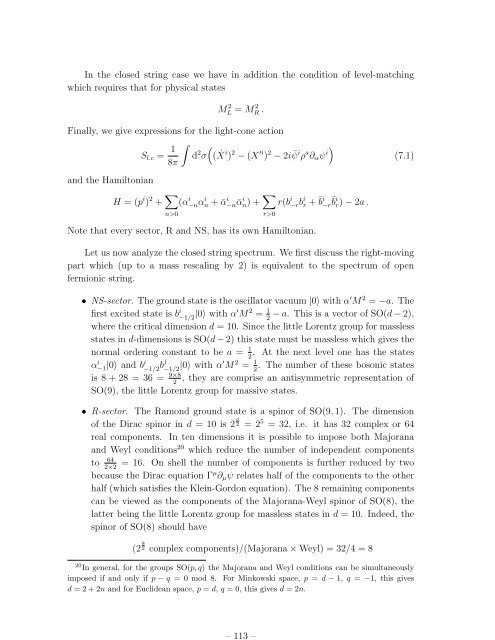Lectures on String Theory
Lectures on String Theory
Lectures on String Theory
You also want an ePaper? Increase the reach of your titles
YUMPU automatically turns print PDFs into web optimized ePapers that Google loves.
– 113 –<br />
In the closed string case we have in additi<strong>on</strong> the c<strong>on</strong>diti<strong>on</strong> of level-matching<br />
which requires that for physical states<br />
M 2 L = M 2 R .<br />
Finally, we give expressi<strong>on</strong>s for the light-c<strong>on</strong>e acti<strong>on</strong><br />
S l.c = 1 ∫ ((Ẋi d 2 σ ) 2 − (X ′i ) 2 − 2i<br />
8π<br />
¯ψ<br />
)<br />
i ρ a ∂ α ψ i<br />
and the Hamilt<strong>on</strong>ian<br />
(7.1)<br />
H = (p i ) 2 + ∑ n>0<br />
(α i −nα i n + ᾱ i −nᾱ i n) + ∑ r>0<br />
r(b i −rb i r + ¯b i −r¯b i r) − 2a .<br />
Note that every sector, R and NS, has its own Hamilt<strong>on</strong>ian.<br />
Let us now analyze the closed string spectrum. We first discuss the right-moving<br />
part which (up to a mass rescaling by 2) is equivalent to the spectrum of open<br />
fermi<strong>on</strong>ic string.<br />
• NS-sector. The ground state is the oscillator vacuum |0〉 with α ′ M 2 = −a. The<br />
first excited state is b i −1/2 |0〉 with α′ M 2 = 1 − a. This is a vector of SO(d − 2),<br />
2<br />
where the critical dimensi<strong>on</strong> d = 10. Since the little Lorentz group for massless<br />
states in d-dimensi<strong>on</strong>s is SO(d − 2) this state must be massless which gives the<br />
normal ordering c<strong>on</strong>stant to be a = 1 . At the next level <strong>on</strong>e has the states<br />
2<br />
α−1|0〉 i and b i −1/2 bj −1/2 |0〉 with α′ M 2 = 1 . The number of these bos<strong>on</strong>ic states<br />
2<br />
is 8 + 28 = 36 = 9×8 , they are comprise an antisymmetric representati<strong>on</strong> of<br />
2<br />
SO(9), the little Lorentz group for massive states.<br />
• R-sector. The Ram<strong>on</strong>d ground state is a spinor of SO(9, 1). The dimensi<strong>on</strong><br />
of the Dirac spinor in d = 10 is 2 d 2 = 2 5 = 32, i.e. it has 32 complex or 64<br />
real comp<strong>on</strong>ents. In ten dimensi<strong>on</strong>s it is possible to impose both Majorana<br />
and Weyl c<strong>on</strong>diti<strong>on</strong>s 20 which reduce the number of independent comp<strong>on</strong>ents<br />
to 64 = 16. On shell the number of comp<strong>on</strong>ents is further reduced by two<br />
2×2<br />
because the Dirac equati<strong>on</strong> Γ µ ∂ µ ψ relates half of the comp<strong>on</strong>ents to the other<br />
half (which satisfies the Klein-Gord<strong>on</strong> equati<strong>on</strong>). The 8 remaining comp<strong>on</strong>ents<br />
can be viewed as the comp<strong>on</strong>ents of the Majorana-Weyl spinor of SO(8), the<br />
latter being the little Lorentz group for massless states in d = 10. Indeed, the<br />
spinor of SO(8) should have<br />
(2 8 2 complex comp<strong>on</strong>ents)/(Majorana × Weyl) = 32/4 = 8<br />
20 In general, for the groups SO(p, q) the Majorana and Weyl c<strong>on</strong>diti<strong>on</strong>s can be simultaneously<br />
imposed if and <strong>on</strong>ly if p − q = 0 mod 8. For Minkowski space, p = d − 1, q = −1, this gives<br />
d = 2 + 2n and for Euclidean space, p = d, q = 0, this gives d = 2n.

















